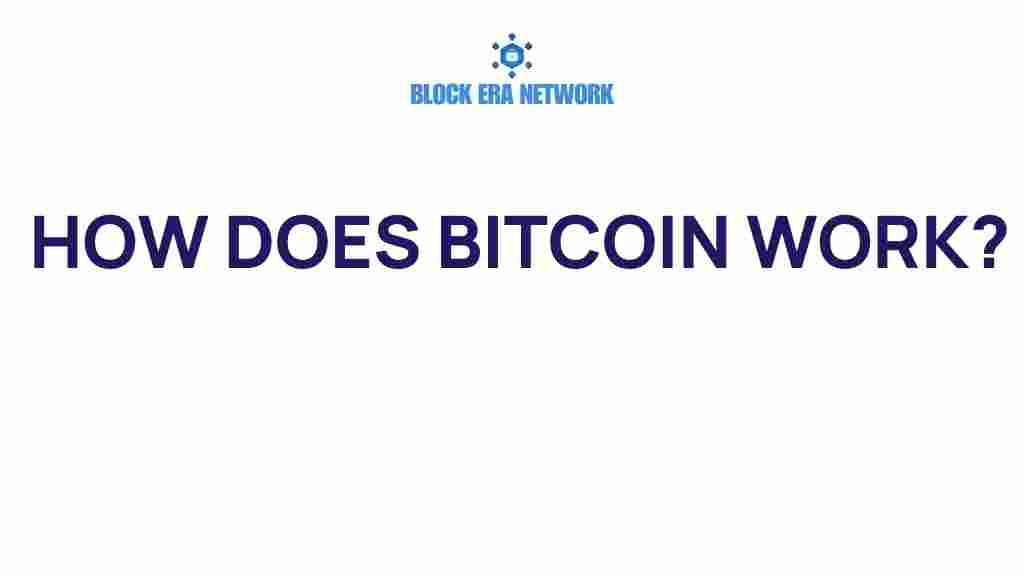What is Bitcoin?
Bitcoin is a decentralized digital currency that operates without the need for a central authority or intermediary like a bank. Created in 2009 by an individual or group using the pseudonym Satoshi Nakamoto, Bitcoin has revolutionized the way we think about money and transactions.
This revolutionary currency is built on blockchain technology, which ensures security, transparency, and immutability. It has gained immense popularity due to its potential as an investment and its ability to enable fast, borderless payments.
How Does Bitcoin Work?
To understand how Bitcoin works, it’s essential to dive into its underlying components and processes. Bitcoin relies on blockchain technology, cryptography, and a peer-to-peer network to function effectively. Below is a detailed breakdown of how Bitcoin operates:
1. Blockchain: The Foundation of Bitcoin
At its core, Bitcoin uses a public ledger known as the blockchain. This ledger contains all the transactions that have ever occurred in the Bitcoin network. The blockchain is maintained by a decentralized network of nodes, ensuring no single entity has control over the data.
- Each transaction is recorded in a “block” and added to the blockchain in a linear, chronological order.
- The immutability of blockchain ensures that once data is added, it cannot be altered or deleted.
2. Mining: Validating Transactions
Bitcoin transactions are validated through a process called mining. Miners use powerful computers to solve complex mathematical problems, ensuring the legitimacy of transactions and securing the network.
- Miners compete to solve these problems, and the first to do so adds the block to the blockchain.
- As a reward, miners receive newly minted Bitcoins and transaction fees.
3. Wallets and Keys: Storing and Accessing Bitcoin
To use Bitcoin, you need a digital wallet. Wallets store your private keys, which allow you to access and manage your Bitcoin. There are several types of wallets:
- Hardware Wallets: Physical devices that store your keys offline.
- Software Wallets: Applications on your computer or smartphone.
- Paper Wallets: A printed document containing your keys.
4. Transactions: Sending and Receiving Bitcoin
Bitcoin transactions involve transferring value from one wallet to another. Each transaction is verified and recorded on the blockchain. Here’s how it works:
- The sender uses their private key to sign the transaction.
- The transaction is broadcast to the network and validated by miners.
- Once validated, the transaction is added to a block on the blockchain.
Benefits of Bitcoin
Bitcoin offers numerous advantages over traditional currencies and payment systems. Some of its key benefits include:
- Decentralization: No central authority controls Bitcoin, making it resistant to censorship and manipulation.
- Transparency: All transactions are publicly recorded on the blockchain.
- Security: Bitcoin uses advanced cryptographic techniques to secure transactions and wallets.
- Low Fees: International transfers often cost less than traditional methods.
- Accessibility: Anyone with an internet connection can use Bitcoin.
Challenges and Troubleshooting Tips
While Bitcoin is revolutionary, it’s not without challenges. Below are some common issues and tips to overcome them:
1. Volatility
Bitcoin’s price is highly volatile, making it risky for short-term investments. To manage this:
- Consider using dollar-cost averaging to reduce the impact of market fluctuations.
- Invest only what you can afford to lose.
2. Security Concerns
Keeping your Bitcoin secure is crucial. Follow these tips:
- Use hardware wallets for long-term storage.
- Enable two-factor authentication (2FA) for added security.
- Never share your private keys.
3. Regulatory Uncertainty
Bitcoin faces varying regulations worldwide. Stay informed by consulting local laws and seeking professional advice if needed.
Learn more about Bitcoin regulations from trusted sources like CoinDesk.
How to Get Started with Bitcoin
Getting started with Bitcoin is straightforward. Follow these steps:
Step 1: Choose a Wallet
Select a wallet that suits your needs, such as a hardware or software wallet.
Step 2: Buy Bitcoin
You can purchase Bitcoin from a cryptocurrency exchange or peer-to-peer platforms. Ensure you use a reputable exchange like Binance.
Step 3: Secure Your Wallet
Take precautions to secure your wallet, such as creating strong passwords and using backup options.
Step 4: Start Using Bitcoin
Use your Bitcoin for purchases, investments, or transferring funds. Explore its versatility in real-world applications!
Conclusion
Bitcoin has transformed the financial landscape, offering a decentralized, secure, and transparent alternative to traditional currencies. By understanding its workings, benefits, and challenges, you can make informed decisions about using this revolutionary currency.
Explore more about Bitcoin and related topics on our cryptocurrency resources page.
This article is in the category and created by Block Era Network Team

6 thoughts on “Unraveling Bitcoin: How Does This Revolutionary Currency Work?”